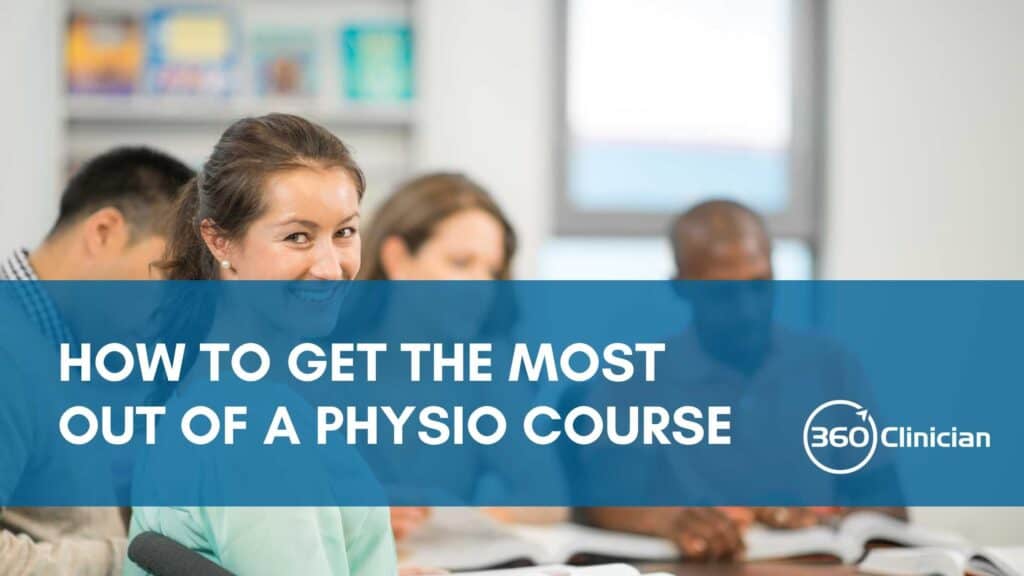We’ve all had those courses that we’ve successfully completed, but haven’t really applied the material in our practices. Courses are costly and time consuming, so it only makes sense that we actually integrate the information we have learned into our practices and grow as professionals. To help you achieve this and get the most of a course, we outlined 3 major phases of taking a course and some tips in each phase to help you get the most out of your course.
Physio Course Preparation
It is important to be prepared for the course that you are taking. By taking the necessary steps to make sure you are prepared, you will not only have a better understand of the material, but also how you will integrate the information into your practice.
Do Your Research Before Hand
It’s always important to start with the end in mind by asking some important questions like:
- Why am I interested in this course?
- What am I hoping to get out of this course?
- Will it add value to my practice?
Having a clear idea of what you hope to gain from the course is such an important first step and will help you avoid disappointment later on.
Think Ahead
Thinking about some patients on your current caseload that you would use as case studies for what you learn in the course can help make the material more relevant and help you to integrate material more effectively in your practice.
Be Prepared
This is probably obvious, but reading any pre-course material and relevant background information will help make sure that you are prepared to learn the new material.
Review the Learning Outcomes/Objectives
Taking a look at the learning outcomes before starting the course will give you direction and help you to prioritize the information learned in the course. While you’re at it, it’s a good idea to think about the learning outcomes that are most relevant for you and your practice and to take special care to ensure you achieve them.
“Education is learning what you didn’t even know you didn’t know.” – Daniel J. Boorstin
Physio Course Application
Courses are often provided over a day, weekend or even multiple weekends and each day is jam-packed with information. We all want to make sure that we take in as much information as we can and integrate all this information into practice. The amount of information can feel daunting at times, but our major tip to help you manage all the new information is simply to be proactive during the course!
Develop Practice-Ready Notes
Taking notes during a lecture is a given as it will help you retain information, improve your recall of that information, and will help in preparing for an exam. But it is also useful to take 20 minutes after the material is presented to fill in any blanks in your notes. There is often a great deal of information given to you in a short period of time, which can lead to incomplete notes or missing information. By reviewing your notes immediately after the material is presented, you are more likely to recall the information you missed and fill in any blanks.
Ask Questions
Be sure to take advantage of your instructors (and your peers) expertise and knowledge to help you gain a greater understanding of concepts/techniques in the course. You may also want to try making a voice memo to record questions that you have during the course as well as the answers to those questions for reference after the course. Be sure to ask if recording is allowed by the course instructor first before you do so.
Take Advantage of In-Class Time
A great way to make sure you are getting the most out of in-class time is to videotape instructor demonstrations of techniques or concepts covered (if permitted). As well, it is important to be assertive with your learning. You have limited in-class time, so you need to make sure you have your instructor, teaching assistant, or even a peer observing your technique and to ask for feedback regularly.
“For the things we have to learn before we can do them, we learn by doing them.”- Aristotle
Physio Course Practice Integration
Practice integration seems to be a phase that is a common issue for physiotherapists. After completing a course, we can often feel like we haven’t applied anything we learned in a course and get discouraged as a result. Here are a few tips to help you integrate course material better and get the value you are looking for out of a course.
Review Course Material and Highlight 3 Key Takeaways
After completing a course, review all the material and highlight 3 major concepts/techniques that you want to integrate into your practice. By choosing 3 important takeaways, you are more likely to understand and integrate them more thoroughly and effectively into your practice instead of trying to incorporate all the information you have learned.
Once you have chosen your 3 takeaways, make sure you commit to them:
- Review the relevant material
- Rewrite important concepts
- Ask a colleague or physiotherapy aide to help you practice
Review Your Caseload Again
At the beginning of your work week, review the patients on your caseload and determine who could benefit from what you have learned in the course. As well, refer back to the patients that you considered as case studies in the preparation phase and make a treatment plan to put the information you have learned into practice. Be sure to schedule enough time to avoid feeling rushed when incorporating the new information you have learned.
Keep in Contact With Your Peers
Make it a goal to connect with 1-2 people in the class after completing the course with the intention of discussing integration of course material into practice. It is always great to make friends with other colleagues and plan to connect after the course, but the issue is often in the follow-through. Try to set up a specific time to follow-up with these colleagues to discuss information integration. For example, you could make it a goal to connect twice over the next couple months. You can even create a Facebook group for a course you’ve taken to create an online medium for information sharing between your peers.
Keep the Contact Info From Your Instructor (If Offered)
Use your instructors as a continuing resource after your course. This is a great way to ask questions or discuss specific problems that may arise as you are working to integrate the material into practice.

